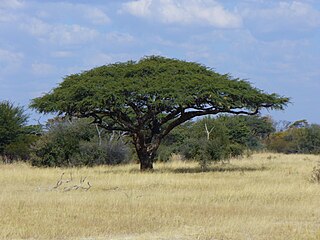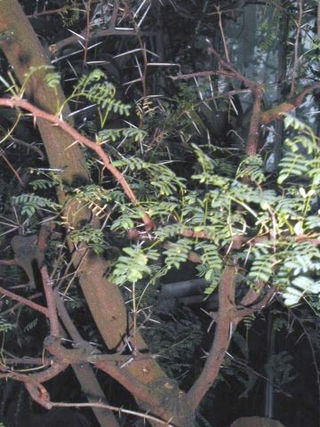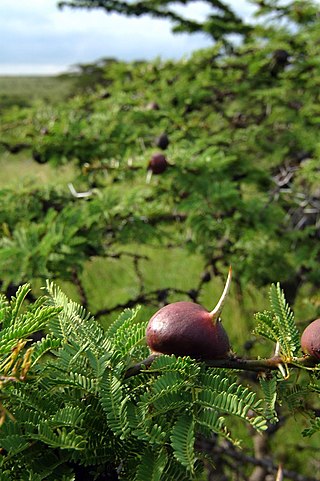
Vachellia farnesiana, also known as Acacia farnesiana, and previously Mimosa farnesiana, commonly known as sweet acacia, huisache, casha tree, or needle bush, is a species of shrub or small tree in the legume family, Fabaceae. Its flowers are used in the perfume industry.

Vachellia cornigera, commonly known as bullhorn acacia, is a swollen-thorn tree and myrmecophyte native to Mexico and Central America. The common name of "bullhorn" refers to the enlarged, hollowed-out, swollen thorns that occur in pairs at the base of leaves, and resemble the horns of a steer. In Yucatán it is called "subín", in Panama the locals call them "cachito". The trees are commonly found in wet lowlands

Vachellia collinsii, previously Acacia collinsii, is a species of flowering plant native to Central America and parts of Africa.

Vachellia tortilis, widely known as Acacia tortilis but now attributed to the genus Vachellia, is the umbrella thorn acacia, also known as umbrella thorn and Israeli babool, a medium to large canopied tree native to most of Africa, primarily to the savanna and Sahel of Africa, but also occurring in the Middle East.

Vachellia erioloba, the camel thorn, also known as the giraffe thorn, mokala tree, or Kameeldoring in Afrikaans, still more commonly known as Acacia erioloba, is a tree of southern Africa in the family Fabaceae. Its preferred habitat is the deep dry sandy soils in parts of South Africa, Botswana, the western areas of Zimbabwe and Namibia. It is also native to Angola, south-west Mozambique, Zambia and Eswatini. The tree was first described by Ernst Heinrich Friedrich Meyer and Johann Franz Drège in 1836. The camel thorn is a protected tree in South Africa.

Vachellia caven is an ornamental tree in the family Fabaceae. Vachellia caven is native to Argentina, Bolivia, Chile, Paraguay, Uruguay and Rio Grande do Sul in Brazil. It grows four to five metres tall and bears very stiff and sharp white thorns up to 2 cm in length. It blooms in spring, with bright yellow flower clusters 1–2 cm (0.39–0.79 in) in diameter.

Vachellia nilotica, more commonly known as Acacia nilotica, and by the vernacular names of gum arabic tree, babul, thorn mimosa, Egyptian acacia or thorny acacia, is a flowering tree in the family Fabaceae. It is native to Africa, the Middle East and the Indian subcontinent. It is also considered a 'weed of national significance' and an invasive species of concern in Australia, as well as a noxious weed by the federal government of the United States.
Leslie Pedley was an Australian botanist who specialised in the genus Acacia. He is notable for bringing into use the generic name Racosperma, creating a split in the genus, which required some 900 Australian species to be renamed, because the type species of Acacia, Acacia nilotica, now Vachellia nilotica, had a different lineage from the Australian wattles. However, the International Botanical Congress (IBC), held in Melbourne in 2011, ratified its earlier decision to retain the name Acacia for the Australian species, but to rename the African species.

Vachellia horrida is a low spreading shrub or sometimes tree native to both the wet and dry scrublands of tropical to subtropical East Africa. Common names for it are Cape gum, Karroo Thorn and dev-babul. It is also found elsewhere in Africa, Asia, India and South America. It frequently has stipular spines 9.5 cm long. V. horrida is an important browse plant in the tropics, particularly during the dry season.

Vachellia karroo, commonly known as the sweet thorn, common acacia, Karoo thorn, Cape gum or cockspur thorn, is a species of Vachellia, in the Mimosa sub-family (Mimosoideae) of the Fabaceae or pea family, which is native to southern Africa from southern Angola east to Mozambique, and south to South Africa.

Vachellia sieberiana, until recently known as Acacia sieberiana, is a tree native to southern Africa and introduced into Pakistan. It is used in many areas for various purposes. The tree varies from 3 to 25 m in height, with a trunk diameter of 0.6 to 1.8 m. It is not listed as being a threatened species.

Vachellia xanthophloea is a tree in the family Fabaceae, commonly known in English as the fever tree. This species of Vachellia is native to eastern and southern Africa. It has also become a landscape tree in other warm climates, outside of its natural range.

Vachellia drepanolobium, more commonly known as Acacia drepanolobium or whistling thorn, is a swollen-thorn acacia native to East Africa. The whistling thorn grows up to 6 meters tall. It produces a pair of straight spines at each node, some of which have large bulbous bases. These swollen spines are naturally hollow and occupied by any one of several symbiotic ant species. The common name of the plant is derived from the observation that when wind blows over bulbous spines in which ants have made entry and exit holes, they produce a whistling noise.

Vachellia is a genus of flowering plants in the legume family, Fabaceae, commonly known as thorn trees or acacias. It belongs to the subfamily Mimosoideae. Its species were considered members of genus Acacia until 2009. Vachellia can be distinguished from other acacias by its capitate inflorescences and spinescent stipules. Before discovery of the New World, Europeans in the Mediterranean region were familiar with several species of Vachellia, which they knew as sources of medicine, and had names for them that they inherited from the Greeks and Romans.

Vachellia reficiens, commonly known as red-bark acacia, red thorn, false umbrella tree, or false umbrella thorn, is a deciduous tree or shrub of the pea family (Fabaceae) native to southern Africa, often growing in an upside-down cone shape and with a relatively flat crown.

Vachellia haematoxylon is a protected tree native to central and southeast Namibia, southwest Botswana and the Northern Cape of South Africa.

Vachellia abyssinica, the flat top acacia, is a tree up to 16 m tall.

Vachellia robusta, the splendid thorn, is an Afrotropical tree species.
Bull horn acacia is a common name for several plants in Vachellia with large thorns resembling a bull's horns:

Senegalia hereroensis is a species of trees in the genus Senegalia. It is indigenous to Southern Africa, and its native range includes western Zimbabwe, Botswana, and Namibia, and the Northern Provinces, Cape Provinces, and Free State of South Africa. It is native to Zambezian wooded grassland (savanna), and wooded grasslands of the Kalahari-Highveld regional transition zone.

















